Your Complete Guide to Stocking an Armenian Pantry
Everything you need to know about the pantry staples of Armenian cuisine.
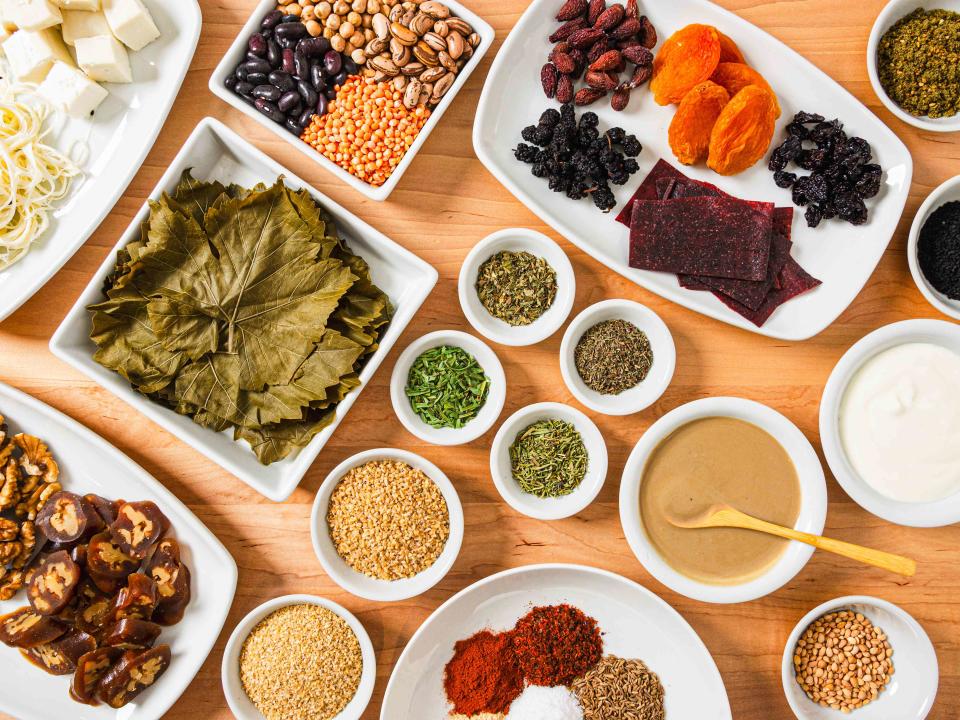
Serious Eats / Andrew Janjigian
Armenian cuisine is ancient, dating back to at least 400 BC. Historical Armenia was located both along one of the Silk Road routes and another busy trade route between the Black and Caspian seas, allowing exchanges of culinary influences from afar. The region is also where a number of key domesticated food crops have flourished historically, including wheat and barley, grapes, apricots, and peaches, and these foods are central to its cuisine.
Armenians love meat, especially lamb, but relative poverty meant that meat was usually reserved for special occasions until fairly recently. The Kingdom of Armenia was the first to adopt Christianity nationwide in the 4th century AD, and ecclesiastical restrictions on the consumption of meat meant that Armenia developed a robust vegetarian cuisine, embracing the use of beans, lentils, nuts, and dairy products like yogurt and cheese.
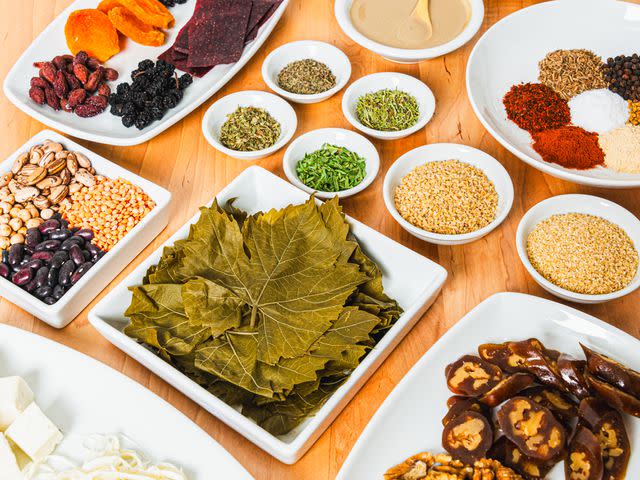
Serious Eats / Andrew Janjigian
Below, you’ll find a list of the key ingredients of Armenian cuisine, with tips for their use and where to find them. Many are easily found in any supermarket, while others will require a little more effort. You'll find Armenian markets in metropolitan areas of the United States and Canada where there are significant Armenian populations, but many of the specialty ingredients used in Armenian cooking can also be found in Arabic and Middle Eastern markets. In addition, many online stores, including My Little Armenia and House of Lavash, sell Armenian products. For high-quality spices, I recommend both Burlap and Barrel and Curio Spice.
Dairy Products
Butter
Butter is essential in Armenian cooking, where it is used as a fat for many savory dishes, including rice pilaf and harissa, and for sweets like gata and other cakes and cookies. For example, copious amounts of it are essential for making the classic Armenian Easter bread known as choreg.
Cheese
Armenians eat and cook with a wide variety of cheeses, and dishes like the buttery, crisp, phyllo-wrapped turnovers called borek feature multiple kinds of cheese. But perhaps the most iconic is string cheese (tel banir), without which no Armenian mezze platter is complete. Unlike the shrink-wrapped sticks of string cheese favored by American schoolchildren, which is usually an aged mild cheddar or mozzarella, Armenian string cheese is a fresh cheese preserved in a brine, similar to feta. It is made by heating cow’s milk curds, adding spices, then stretching and layering them into long ropes, similar to how hand-pulled noodles are made. Once the ropes are formed, they are braided and submerged in brine.
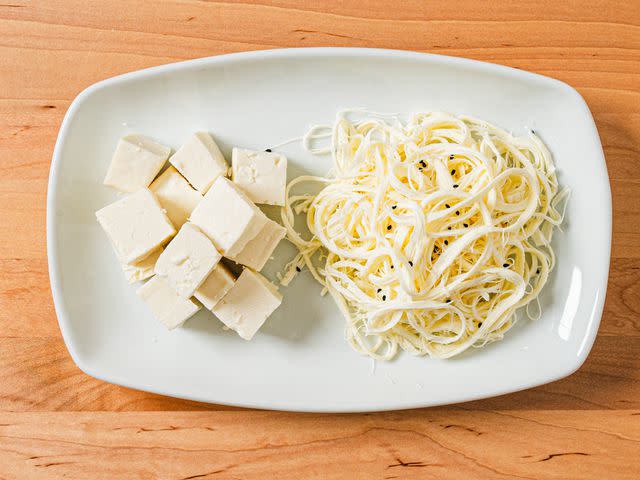
Serious Eats / Andrew Janjigian
Armenians also use tangy hard cow’s milk cheeses in dishes such as boreks and su boreg. One of the most popular varieties of these hard cheeses is called lori, a slightly salty, tangy hard cheese similar to Muenster. Salty sheep’s milk cheeses like feta also figure prominently in Armenian cuisine.
Yogurt
Yogurt is ubiquitous on the Armenian table, and is used in many Armenian dishes both savory and sweet. (Armenians introduced yogurt to the wider American world, when Columbo Yogurt was founded in 1929 by Rose and Sarkis Colombosian, in Andover, Massachusetts.) Armenian yogurt is usually plain, full-fat yogurt made from cow’s milk. It is used as a condiment—either plain or mixed with a little minced garlic—for many savory dishes, including manti and ganach lupia, and bowls of yogurt are commonly set on the table as a universal condiment. It also serves as the base of soups, including tanabour, a grain-and-yogurt soup that is served both hot and cold, and the soup-like dip made from yogurt and cucumbers known as djadjekh. Thin yogurt with water, and you’ll get a cooling Armenian drink known as tan. Yogurt is often used as the liquid or dairy component in cakes and sweets, including in gata, or Armenian coffee cake.
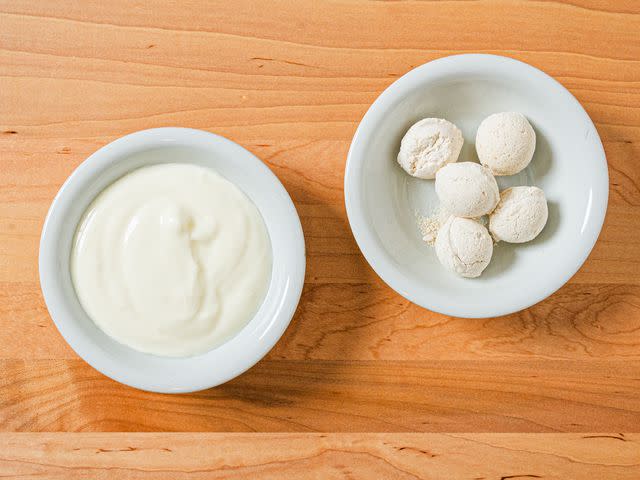
Serious Eats /Andrew Janjigian
Some Armenians also use chortan, also known as khash, which is yogurt that has been dried down into brittle chunks to preserve it. It can be rehydrated in water and used like yogurt in dishes.
Fresh Herbs and Greens
Herbs, both fresh and dried, are essential to Armenian savory cooking. Armenian food is less reliant on spices for flavor than many other regional cuisines, with aromatic herbs doing the work instead.
Fresh herbs like purple basil, scallions, dill, mint, flat-leaf parsley, cilantro, tarragon, and summer savory are used as a garnish (often in combination) for many dishes, either chopped fine, as in dishes like eetch, chi kofte, and vospov kofte, or left whole and served as a sort of side salad. (The filling for jingalov hats, an unleavened flatbread from Artzakhis made using a finely chopped combination of these sorts of herbs, along with others collected from the wild.)
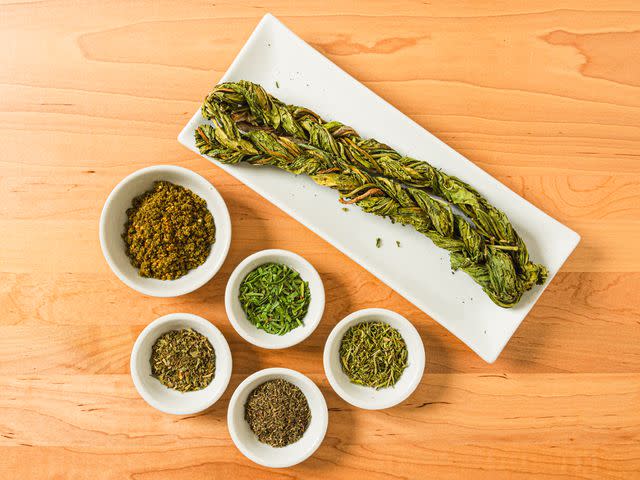
Serious Eats / Andrew Janjigian
Purslane
One fresh green especially beloved by Armenians is purslane, or per per, which has a tart flavor and a crisp texture. Purslane is used in salads or chopped up and added to soups both cold and hot. Though the herb isn’t very well known here in the United States unless you’re a forager, it grows as a weed in many places. Purslane also grows like a weed—it makes so many seeds that it can be hard to eliminate once it shows up, so you should do as many Armenians do and embrace it.
Dried Herbs
As for dried herbs, mint (spearmint, not the menthol-heavy peppermint used to make mint tea) is an essential flavoring for many Armenian soups and stews. Other dried herbs used in Armenian cuisine include za’atar (a wild herb in the oregano family that is also the basis of an herb and spice blend by the same name), savory, tarragon, sorrel, and thyme.
Nuts and Seeds
Nuts
Walnuts are the essential nut of Armenian cuisine. In savory dishes they are used as a base, like in the spicy dip muhammara, and as a component in numerous soups. Walnuts are also used as the filling for a variety of sweets, including many cookies, cakes like gata and nazook, and phyllo pastries such as bourma, baklava, and kunafe. The Armenian “sweet sausage" called rojik is made by tying walnuts a few inches apart on a string, which is then dipped over and over again into a molten pot of grape molasses and allowed to cool, not unlike how candles are formed. It's sliced thin and served as a mezze item.
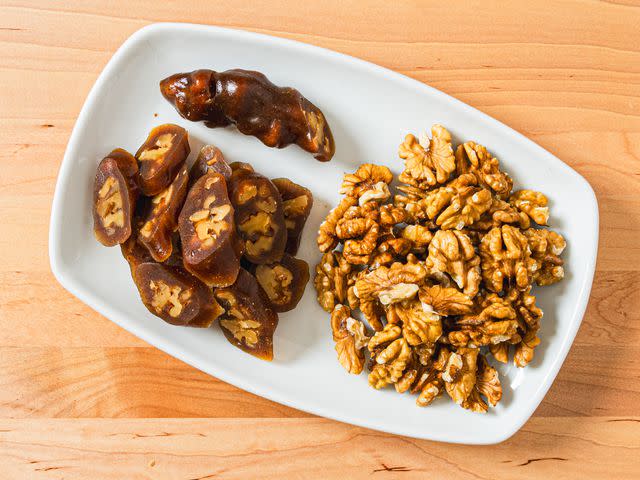
Serious Eats / Andrew Janjigian
Almonds, pistachios, hazelnuts, and pine nuts are also commonly used in Armenian cuisine, used whole as elements of pilafs and other rice dishes, and whole or ground in sweets.
Tahini Paste
Tahini paste, made from roasted, ground sesame seeds, is used in a variety of Armenian foods, both sweet and savory. It's used in the filling for a vegetarian potato-chickpea dumpling called topik, and in both hummus and baba ganoush, two Middle Eastern dishes beloved by Armenians. In sweet applications, it appears in cookies and as the filling for tahinov hats, or Armenian tahini bread, a laminated flatbread.
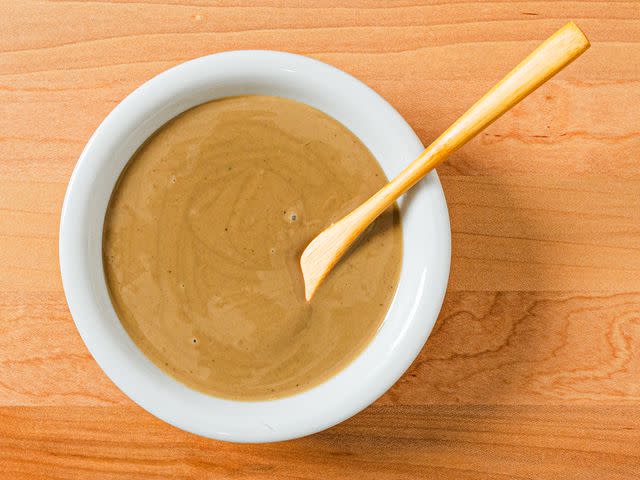
Serious Eats / Andrew Janjigian
Fruits
Dried Fruits
A trip to an Armenian grocery store will yield a panoply of dried fruits, including raisins, mulberries, figs, dates, and two kinds of sour cherries—a true tart cherry, along with Cornelian cherries, which are actually the fruit of a Dogwood tree . But the dried fruit Armenians love most is apricots, which originated in the area (the species name for apricots is Prunus armeniaca). They are served as part of a mezze spread, and as a component in numerous starch-thickened puddings, as well as a traditional New Year's sweet porridge called anoush abour, made with wheat berries, dried fruit, and nuts.
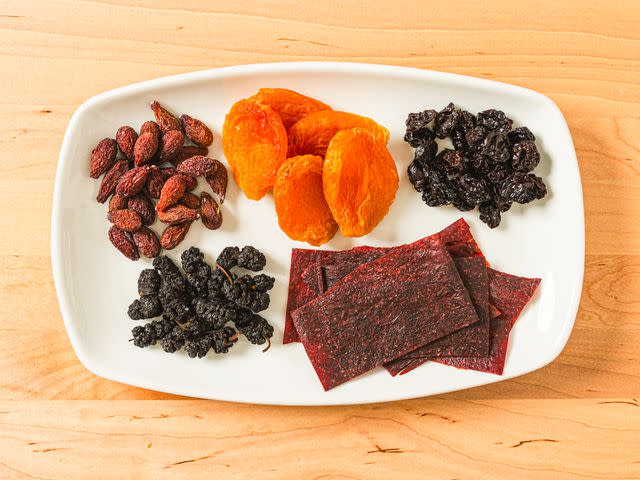
Serious Eats / Andrew Janjigian
Grape, mulberry, and pomegranate molasses appear frequently in Armenian cuisine, as souring agents in dishes like muhammara and eetch, and as the base for rojik.
Armenians also make a variety of dried fruit leathers using apples, grapes, apricots, and plums; they are known as bastegh or t’tu lavash (“sour lavash”) a nod to their resemblance to the classic Armenian flatbread.
Fresh Fruits
Apricots, peaches, grapes, cherries, quince, and mulberries feature heavily in Armenian cuisine and culture, but pomegranates are the most prized fruit. The pomegranate symbolizes eternity to Armenians and appears regularly in artwork, woven rugs, and jewelry, both modern and historical. The seeds are eaten out of hand and as a garnish for various dishes both savory and sweet.
Dried Spices
Armenians use a wide variety of dried spices in their cooking, including cumin, black pepper, dried garlic, paprika, cayenne, fenugreek, allspice, cinnamon, nutmeg, and clove. Hot red pepper flakes like Aleppo pepper are regularly used for their heat and fruity fragrance.
Chemen
One classic ground spice blend used in Armenian cuisine is chemen, a mixture of cumin, black pepper, garlic powder, hot red pepper, paprika, fenugreek, and salt. It is used as a rub for basturma, a dry-cured beef, and to season soujouk, a dried beef sausage.
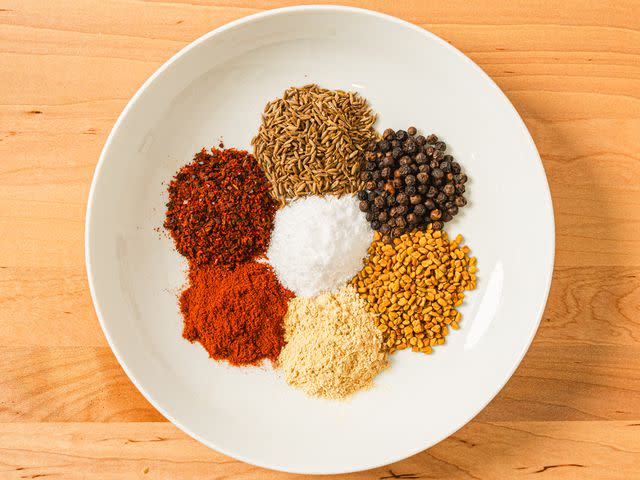
Serious Eats / Andrew Janjigian
Mahlab
Mahlab is made from the tiny seeds of the St. Lucy's cherry (Prunus mahaleb), a tree native to the Mediterranean, Iran, and parts of Central Asia. Because the seeds are extremely hard, they're always ground into a fine powder before use. Along with nigella, it is one of the two key flavoring ingredients for choreg, or Armenian Easter bread, and it is commonly used to flavor Armenian string cheese. Its flavor is aromatic and complex, drawing comparisons to cherry, almond, vanilla, and rose.
The oils in mahlab are extremely quick to oxidize and turn rancid if exposed to air, so it’s best to purchase whole mahlab, store them in a sealed container in the freezer, and grind them in a spice mill or mortar and pestle just before use. If you can only find ground mahlab, use it soon after purchase, and store the remainder in the freezer. In my experience, the mahlab sold in many Middle Eastern grocery stores is often already rancid, so your best bet is to source it from a reputable online merchant; I like the mahlab from Curio Spice.
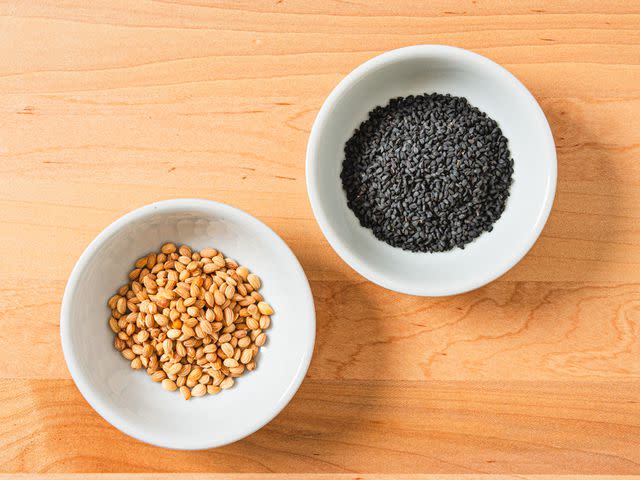
Serious Eats / Andrew Janjigian
Nigella
Nigella is referred to variously as "black cumin," "black caraway," "onion seed," "black sesame," and even "fennel flower,” although it isn't botanically related to any of those spices and vegetables. Nigella is wonderfully complex, and with its notes of citrus, pine, and menthol, it's easy to see why it's compared to so many other spices. Nigella is also bitter, which is why it's almost always left whole rather than ground into a powder, so its aroma can infuse a dish without the bitter flavor taking over. Nigella is used in choreg, and is added to Armenian string cheese. It's also used to decorate breads and pastries, like boreks.
Sumac
Sumac is a drupe that grows on trees, and is usually sold as a powdered spice. It lends foods a sour flavor, and along with the herb za’atar and sesame seeds, is one of the key ingredients in the za’atar spice blend, Sumac is often sprinkled over a dish for a hit of tartness in Armenian cuisine, including on sini manti and many salads.
Preserved Items
Grape Leaves
Grape leaves are used as wrappers for sarma, or stuffed grape leaves, which can be filled with a spiced rice mixture and served at room temperature, or filled with a combination of meat and rice to be served hot. Grape leaves that have been preserved in brine are sold in jars. They should be rinsed and patted dry before use.
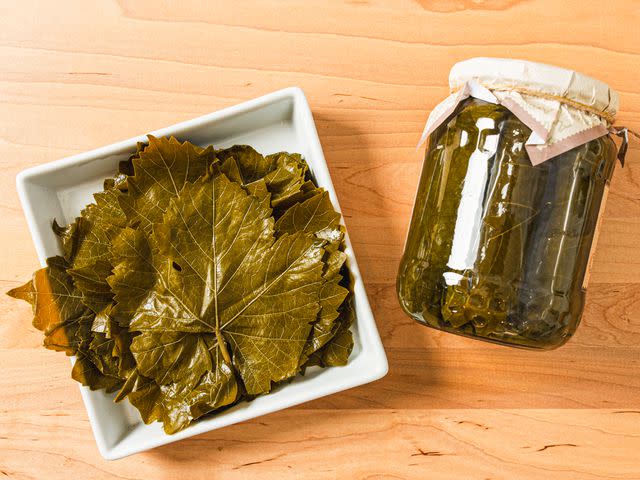
Serious Eats / Andrew Janjigian
Red Pepper Paste (Beghbeghi Tchur)
Along with tomato paste (with which it is commonly combined), red pepper paste made from red bell or large red chile peppers is one of the most important jarred ingredients used in Armenian cuisine. It’s used in a wide variety of dishes for savoriness and a gentle heat, including lahmajun, khorovats, ganach lupia, and losh kebabs.
Legumes
Armenians use a variety of dried beans and legumes in their cooking, but the two most important are red lentils and chickpeas. Red lentils are used in soups andvegetarian kofte called vospov kofte, among other dishes. Chickpeas feature in soups and stews, salads, and the vegetarian dumplings called topik.also essential in hummus, which isn't exclusively Armenian, but almost always appears on Armenian mezze spreads. Armenians also cook with a small red bean called a Goris bean, which is similar to a cranberry bean (there’s also a purple-black variant), and it is the base for the filling in my lavash triangles recipe.
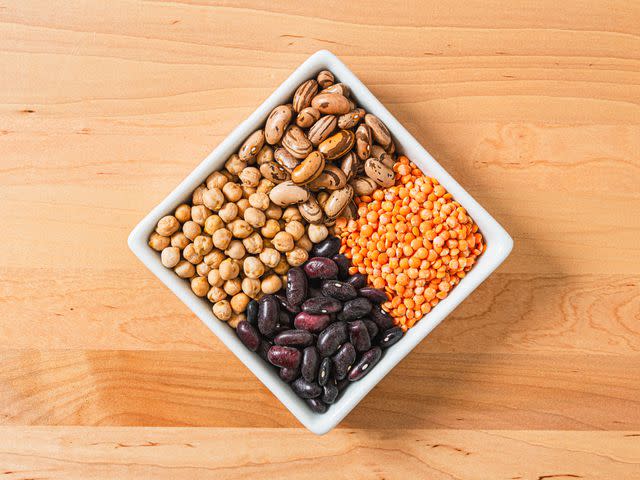
Serious Eats / Andrew Janjigian
Grains, Pasta, and Wheat Products
Armenians use a wide variety of dried grains in their cooking, including barley, buckwheat, and hulled wheat berries, the last of which is used to make the chicken-and-wheat porridge known as harissa. Along with wheat flour, semolina (a coarsely-ground durum flour) is commonly used in puddings, cakes, and cookies. Long-grain white rice is used to make Armenian rice pilaf and to fill dolma (stuffed vegetables) and sarma (stuffed grape leaves).
Bulgur
Other than rice, maybe the most important grain for Armenians is bulgur, which is par-boiled and dried cracked durum wheat. This quick-cooking whole grain is used in eetch, vospov kofte, tabbouleh (and other salads), as a starchy filler for a variety of meatballs (kofta), and is often used to make pilaf. (Bulgur is quick to turn rancid when exposed to oxygen, so it’s best stored in the fridge or freezer.)
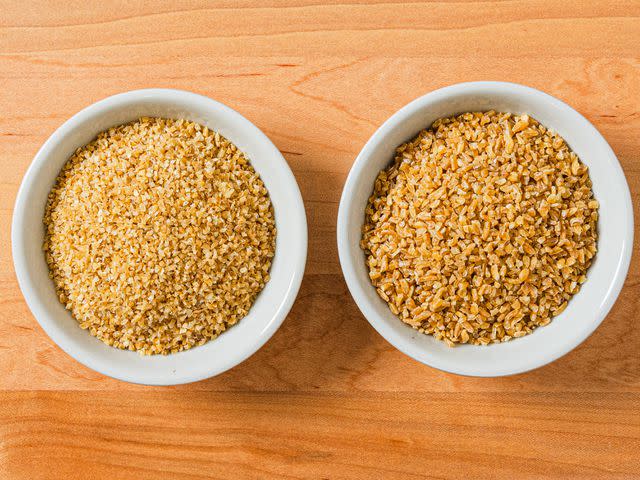
Serious Eats / Andrew Janjigian
Lavash
Lavash is so central to Armenian culture that it was recently added to UNESCO’s Representative List of the Intangible Cultural Heritage of Humanity. (It also appears separately on that list as culturally important to Armenia's neighbors Azerbaijan, Iran, Kazakhstan, Kyrgyzstan, and Turkey.) Lavash is used as a wrap for meats like losh kebab and khorovats and as an edible utensil for dishes like eetch, harissa, and dips such as hummus and baba ganoush. It can also be used in place of phyllo to make filled turnovers like my lavash triangles. Other popular breads in Armenia include pita, choreg, and matnakash.
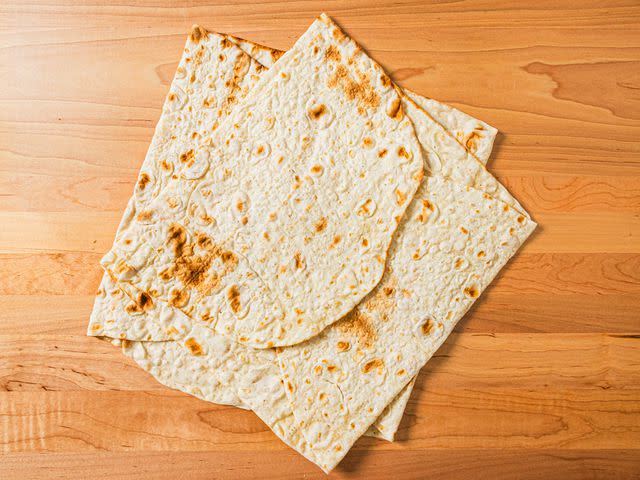
Serious Eats / Andrew Janjigian
Phyllo (Fillo) Dough
Phyllo dough, found in the freezer section of most grocery stores, serves as the wrapper for a variety of Armenian dishes, including savory boreks and the sweet pastries baklava and bourma.
Vermicelli
Along with rice or bulgur, the other key ingredient in Armenian rice pilaf is a fine, long-stranded dried pasta like vermicelli or thin spaghetti. Many Armenians use vermicelli nests, since they are easy to portion out.
Read the original article on Serious Eats.

